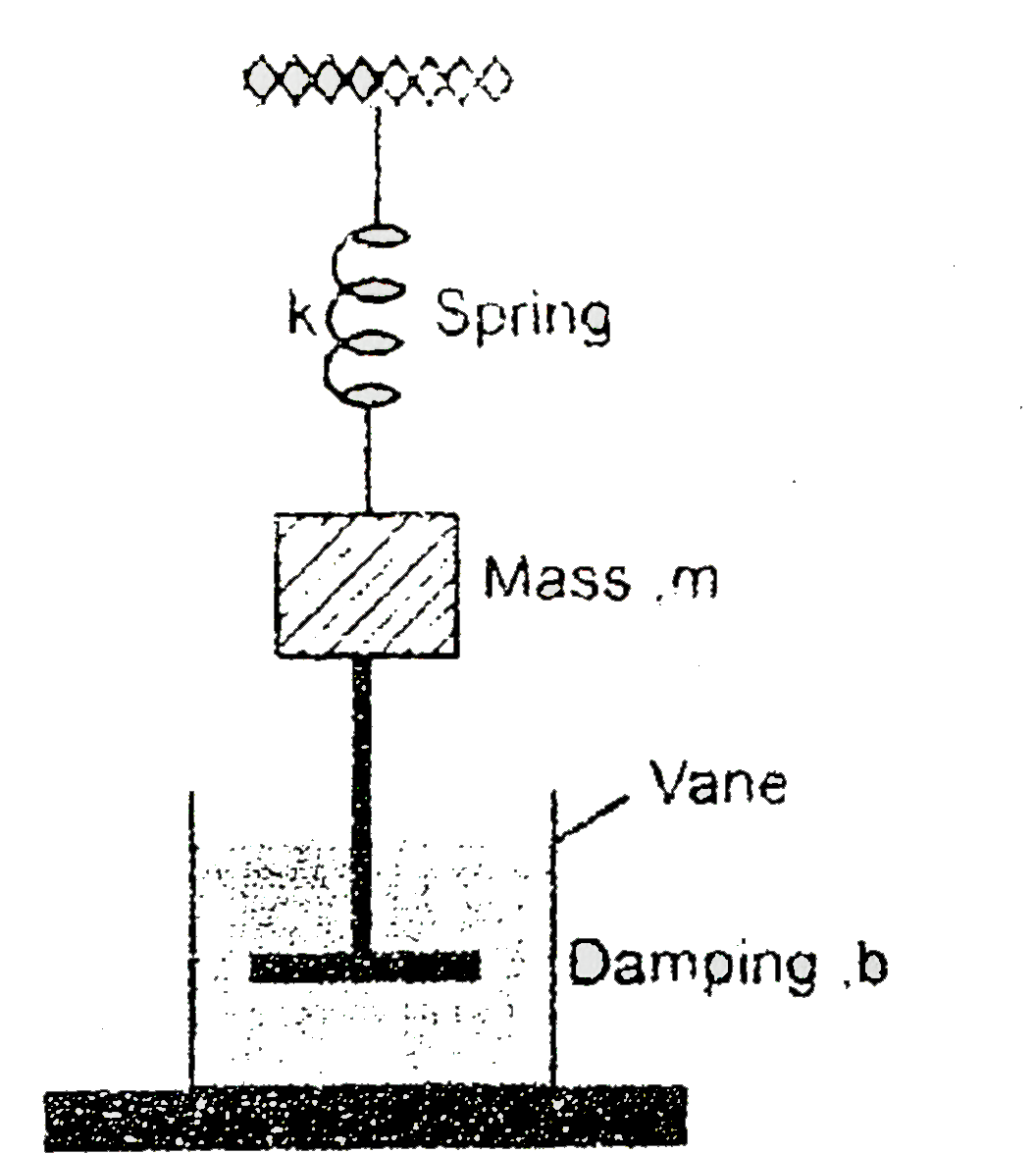For the damped oscillator of Fig. 15.20, m= 250g, k= 85N/m, and b= 70g/s
How long does it take for the amplitude of the damped oscillations to drop to half its initial value?
To solve the problem of how long it takes for the amplitude of a damped oscillator to drop to half its initial value, we can follow these steps:
1. Identify the given values:
- Mass m=250g=0.25kg
- Spring constant k=85N/m
- Damping coefficient b=70g/s=0.07kg/s
2. Write the equation for the amplitude of a damped oscillator:
The amplitude of a damped oscillator at time t is given by:
x(t)=xmaxe−b2mt
where xmax is the initial amplitude.
3. Set up the equation for half the initial amplitude:
We want to find the time t when the amplitude x(t) is half of the initial amplitude xmax:
x(t)=12xmax
Substituting this into the amplitude equation gives:
12xmax=xmaxe−b2mt
4. Cancel xmax:
Since xmax is non-zero, we can divide both sides by xmax:
12=e−b2mt
5. Take the natural logarithm of both sides:
Taking the natural logarithm gives:
ln(12)=−b2mt
6. Solve for t:
Rearranging the equation to solve for t:
t=−2mbln(12)
We can use the property of logarithms: ln(12)=−ln(2):
t=2mbln(2)
7. Substitute the values:
Now substitute the values of m and b:
t=2×0.25kg0.07kg/sln(2)
t=0.50.07ln(2)
t≈7.14ln(2)
Using ln(2)≈0.693:
t≈7.14×0.693≈4.94s
Final Answer:
The time it takes for the amplitude of the damped oscillations to drop to half its initial value is approximately 4.94 seconds.
- Mass m=250g=0.25kg
- Spring constant k=85N/m
- Damping coefficient b=70g/s=0.07kg/s
The amplitude of a damped oscillator at time t is given by:
x(t)=xmaxe−b2mt
where xmax is the initial amplitude.
We want to find the time t when the amplitude x(t) is half of the initial amplitude xmax:
x(t)=12xmax
Substituting this into the amplitude equation gives:
12xmax=xmaxe−b2mt
Since xmax is non-zero, we can divide both sides by xmax:
12=e−b2mt
Taking the natural logarithm gives:
ln(12)=−b2mt
Rearranging the equation to solve for t:
t=−2mbln(12)
We can use the property of logarithms: ln(12)=−ln(2):
t=2mbln(2)
Now substitute the values of m and b:
t=2×0.25kg0.07kg/sln(2)
t=0.50.07ln(2)
t≈7.14ln(2)
Using ln(2)≈0.693:
t≈7.14×0.693≈4.94s
The time it takes for the amplitude of the damped oscillations to drop to half its initial value is approximately 4.94 seconds.
Topper's Solved these Questions
- BOOK - RESNICK AND HALLIDAYCHAPTER - OSCILLATIONSEXERCISE - Checkpoint8videos
OSCILLATIONS
- BOOK - RESNICK AND HALLIDAYCHAPTER - OSCILLATIONSEXERCISE - Problems39videos
OSCILLATIONS
- BOOK - RESNICK AND HALLIDAYCHAPTER - MOTION IN TWO AND THREE DIMENSIONSEXERCISE - PRACTICE QUESTIONS (MATRIX-MATCH)10videos
MOTION IN TWO AND THREE DIMENSIONS
- BOOK - RESNICK AND HALLIDAYCHAPTER - PHOTONS AND MATTER WAVESEXERCISE - PRACTICE QUESTIONS(Integer Type)4videos
PHOTONS AND MATTER WAVES
Similar Questions
Knowledge Check
- Question 1 - Select One
For a damped oscillation m=500 gm ,k=100 N/m,b=75 gm/sec. What is the ratio of amplitue of damped oscillation to the intial amplitude at the end of 20 cycles
⎡⎢⎣given1e0.675=0.5,1e0.51=0.6⎤⎥⎦A0.6B0.51C0.4Dnone
For a damped oscillator damping constant is 20gm/s, mass is 500gm. Find time taken for the amplitude to become half the initial
View SolutionAmplitude of mass spring system which is executing SHM decreases with time. If mass = 500g decay constant = 20 g/s then how much time is required for the amplitude of the system to drop to half of its initial value.
View SolutionAmplitude of a mass-spring system, which is executing simple harmonic motion decreases with time. If mass=500g, Decay constant=20 g/s then how much time is required for the amplitude of the system to drop to half of its initial value ? (In 2=0.693)
View SolutionFor the damped oscillator shown in previous Figure, the mass m of the block is 400 g, k=45Nm−1 and the damping constant b is 80gs−1. Calculate .
(a) The period of osciallation ,
(b) Time taken for its amplitude of vibrations to drop to half of its initial value and
(c ) The time taken for its mechanical energy to drop to half its initial value.View SolutionFor the damped oscillator shown in Fig, the mass of the block is 200g,k=80Nm−1 and the damping constant b is 40gs−1 Calculate
(a) The period of oscillation
(b) Time taken for its amplitude of vibrations to drop to half of its initial values
(c) The time for the mechanical energy to drop to half initial values
 View Solution
View SolutionHere are three sets of values for the spring constant, damping constant, and mass for the damped oscillator of Fig. 15.17. Rank the sets according to the time required for the mechanical energy to decrease to one-fourth of its initial value, greatest first.
¯¯¯¯¯¯¯¯¯¯¯¯¯¯¯¯¯¯¯¯¯¯¯¯¯¯¯¯¯¯Set 12k0 b0 m0Set 2 k0 6b0 4m0Set 33k0 3b0 m0–––––––––––––––––––––View SolutionIn damped oscillatory motion a block of mass 20kg is suspended to a spring of force constant 90N/m in a medium and damping constant is 40g/s. Find (a) time period of oscillation (b) time taken for amplitude of oscillation to drop to half of its intial value (c) time taken for its mechanical energy to drop to half of its initial value.
View Solution
